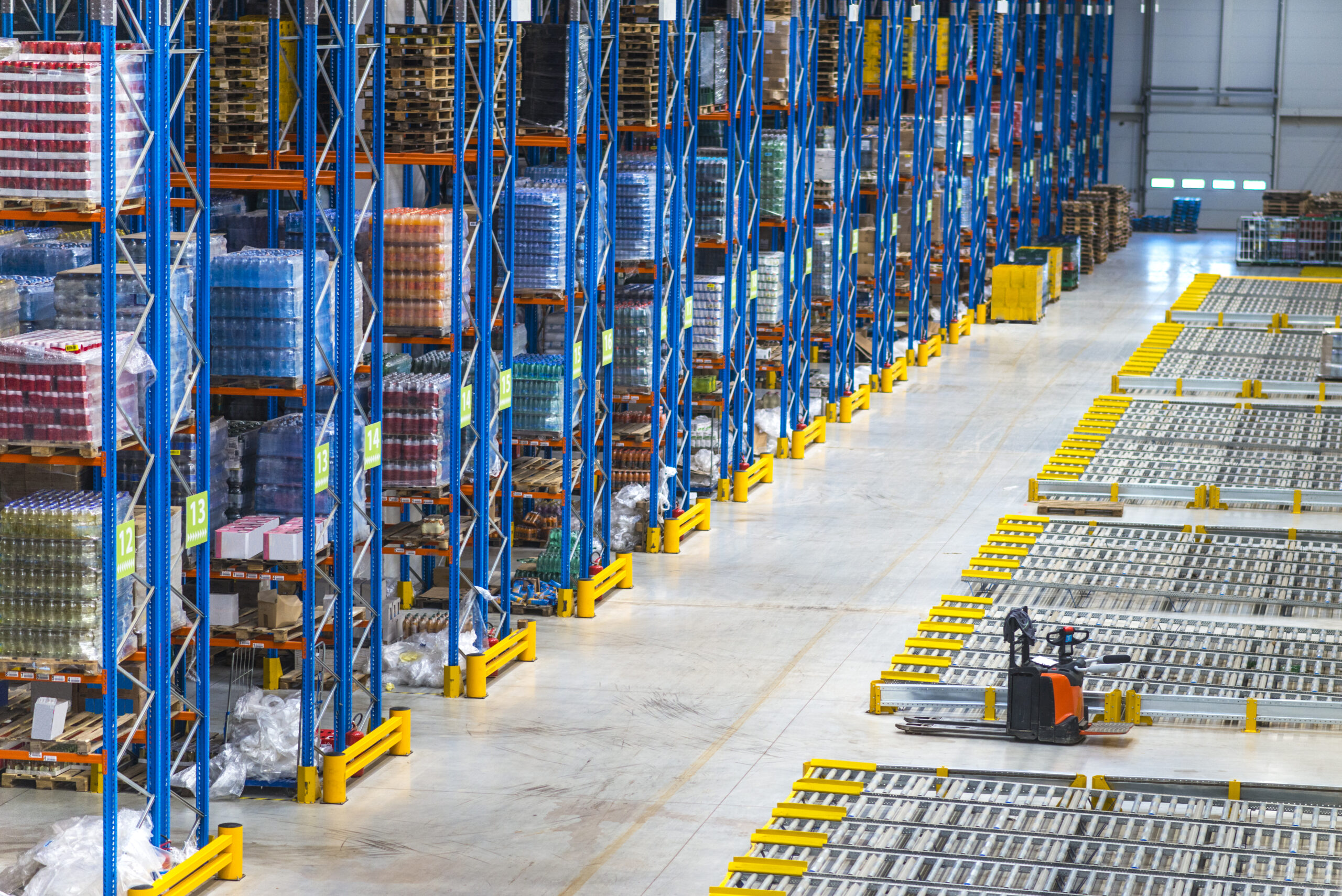Are your fulfillment operations experiencing bottlenecks? Are order fulfillment times slipping due to inefficiencies in your warehouse layout?
Warehouse layout plays a direct role in operational efficiency, order accuracy, inventory management, and overall workflow. An optimized layout aligns storage, picking processes, and equipment in a logical way to minimize wasted motion and maximize productivity. In fact, businesses can find 15-18% more space if they reassess the layout, aisle space, and honeycombs.
For companies that handle physical products, getting the warehouse layout right is one of the most impactful ways to improve the bottom line.
What is a Warehouse Layout?
A warehouse layout refers to the floor plan and physical organization of a warehouse. It determines where inventory and equipment are stored and the path through which products flow.
The warehouse layout directly impacts the efficiency of warehouse operations. An optimal warehouse layout allows workers, inventory, and material handling equipment to move efficiently to perform storage and order fulfillment tasks.
At its core, warehouse layout design involves strategically locating storage areas, aisles, docks, receiving and shipping areas, as well as employee and office spaces within the warehouse. The goal is to create an organized environment that minimizes unproductive movements and makes the best use of available warehouse space.
Businesses can improve productivity, space utilization, order accuracy, and fulfillment speed by optimizing the warehouse layout for workflow and operational needs.
Read Also: What is Smart Warehousing?
Why is Warehouse Layout Optimization Important?
On average, a warehouse employee spends more than half of their time traveling to the warehouse by forklift or on foot. An optimized warehouse layout can decrease this time and directly increase employee productivity.
An optimized warehouse layout is crucial for any fulfillment operation. The layout directly impacts how efficiently employees can pick, pack, and ship orders. It also affects inventory accuracy, storage capacity, and costs. There are several key reasons why warehouse layout optimization is important:
1. Improves Efficiency
Poorly optimized warehouses tend to spend more on labor. In fact, labor costs cover around 50 to 70 percent of the company’s warehousing budget.
An optimized layout ensures efficient workflows and material flows. Workers don’t have to travel long distances to retrieve or store inventory. This saves significant time and effort, enabling employees to fulfill more orders per day. Shorter pick paths also reduce fatigue.
2. Increases Productivity
By reducing travel time and distance, workers can accomplish more picking and packing within a standard shift. Studies show productivity can improve by 10-30% with an optimized layout. This allows businesses to fulfill more orders with existing staffing.
3. Enhances Accuracy
Inefficient warehouse management leads to issues such as wrong product packaging and delivery. These are the reasons behind 17% of inventory mistakes that lead to lost customers.
When warehouse design considers ergonomics and user experience, there are fewer opportunities for errors. Intuitive layouts with clear signage and storage guidelines minimize misplaced inventory. This improves order accuracy and inventory tracking.
4. Optimizes Storage Capacity
The average amount that businesses spend on warehousing per square foot in the US is $5 to $7. As warehouses become larger, this cost can make a significant dent in budgets. An efficient layout fully utilizes all available storage space, including height. It accommodates current inventory levels and allows for future growth. Businesses avoid the costs of overflow storage or unnecessary facility expansion.
5. Reduces Operational Costs
Increased productivity, space optimization, and more accurate fulfillment directly reduce operational costs related to labor, inventory, materials handling, and storage. Businesses see a return on investment from layout optimization.
According to McKinsey, warehousing operations cost businesses across the world about €300 billion each year. With better layout optimization, this cost can be efficiently reduced.
Read Also: Signs you need a new Canadian Fulfillment Center
3 Key Factors Included in a Good Warehouse Layout
An optimized warehouse layout follows key principles to enable efficient operations. Some main principles include:
1. Minimize Distance
The layout should aim to minimize the distance traveled by warehouse workers and forklifts during order picking and putaway processes. This is achieved by placing high-velocity items closer to shipping areas. Slow movers can be placed in more distant locations. Proper zoning and slotting help minimize travel distances.
2. Logical Flow
There should be a logical flow to how goods move through the warehouse. Receiving docks should be near raw material storage. As goods are processed, they move via efficient routes towards packing, quality checks and finally shipping zones. This smooth flow minimizes non-value-added motion and transport. Clear departmental zones also aid organizations.
3. Space Utilization
The layout design should optimize space utilization. Narrow aisles and selective high-density storage methods can maximize available cubic volume. Enough space should be planned for current and future inventory levels. Space planning assists with occupancy calculations. Proper space utilization also leaves room for forklifts and people to move safely.
4 Types of Warehouse Layouts
When designing a warehouse layout, there are four main types of layouts to consider:
1. Process Layout
A process layout groups similar processes or activities together. This is best for batch production with intermittent flows. Process layouts promote work specialization and possibly better supervision. However, material handling can be inefficient as parts travel longer distances.
2. Product Layout
A product layout aligns the warehouse based on product lines or families. It works well for repetitive standardized operations. Product layouts minimize material handling since processes are close together. However, they lack flexibility and can lead to downtime if one process goes down.
3. Fixed Layout
As the name implies, a fixed layout has a fixed workflow pattern and cannot be easily changed. It is suitable for stable conditions and standardized, high-volume output. While simple to design, fixed layouts lack flexibility.
4. Adaptive Layout
An adaptive layout has moveable equipment and walls that allow for modifications. It provides more flexibility compared to fixed layouts. Adaptive layouts are ideal for changing needs, product varieties, and production requirements. The main downside is the cost of moving and reconfiguring the layout.
How to Design an Optimal Warehouse Layout?

When designing your warehouse layout, follow these key steps:
1. Analyze Operations
The first step is to carefully analyze your operations, including:
- What are your major activities (receiving, order picking, shipping, etc)?
- What is the workflow and volume for each activity?
- How much space does each operation need?
- What equipment do you use for each task?
- How many dock doors and what size doors are needed?
Understanding your operations in detail allows you to allocate the right amount of space and resources for each task.
2. Create a Blueprint
Next, create a blueprint detailing all the areas, dimensions, and equipment placements for your facility.
- Mark receiving and shipping areas close to docks.
- Position high-volume pick areas near outbound docks.
- Allow room for aisles, conveyors, lifts etc.
- Consider future expansion.
Ensure your blueprint aligns with the workflow of your warehouse processes.
3. Implement the Design
With your blueprint complete, it’s time to implement the layout.
- Mark and label all areas, aisles, racks etc.
- Communicate layout to all employees.
- Continuously optimize as needed.
Warehouse Optimization at ShipTop
When partnering with ShipTop, here is the warehouse optimization process you can expect:
Step 1: Facility Evaluation
We start by thoroughly evaluating your facility. This includes analyzing your storage methods, inventory levels, order profiles, product dimensions, and throughput requirements. We identify areas causing congestion or inefficient workflow. Our goal is to understand what’s working well currently and what can be improved.
Step 2: Data Analysis
Next, we analyze important data like peak periods, future projections, constraints, and growth opportunities. This quantitative information guides our warehouse optimization strategy. We determine ideal locations for receiving, put-away, order picking, packing, shipping, and other activities based on data.
Step 3: Layout Redesign
With a solid understanding of your operations, we redesign an optimized layout. We use advanced warehouse modeling software to experiment with different configurations before finalizing our recommended layout. The optimized design improves productivity by minimizing travel distances, congestion, and bottlenecks.
Step 4: Implementation
Once our proposed design is approved, we handle all aspects of implementing the new warehouse layout. We relocate inventory, shelves, machinery and workstations methodically to minimize downtime. We also provide worker training to ensure a smooth transition.
Step 5: Performance Measurement
Post-implementation, we benchmark the redesigned warehouse against key performance indicators. This allows us to quantify improvements in order accuracy, labor efficiency, inventory accuracy, and throughput time. We also suggest any fine-tuning to maximize the benefits of the optimized layout.
Wrapping Up
Having an optimized warehouse layout is more crucial than ever for the success of your fulfillment operations. Following the principles outlined above can help you design a warehouse layout that minimizes labor costs, reduces cycle times, improves accuracy, and maximizes storage capacity and efficiency.
If you are finding warehouse layout optimization to be a challenge, consider outsourcing your fulfillment and warehouse needs to ShipTop. With decades of experience in fulfillment services, we have developed tailored fulfillment strategies that meet our client’s specific needs and objectives.
Whether you are scaling your business or simply want to outsource fulfillment to third-party logistics, get in touch with us. With strategically distributed warehouses in Canada and the United States, we will help you surpass the warehouse layout optimization stress.




